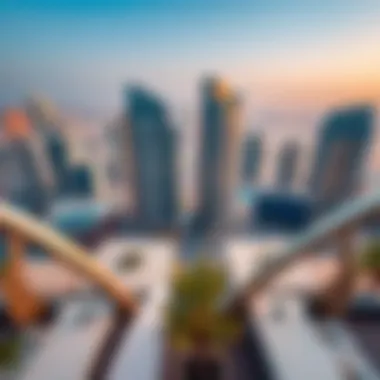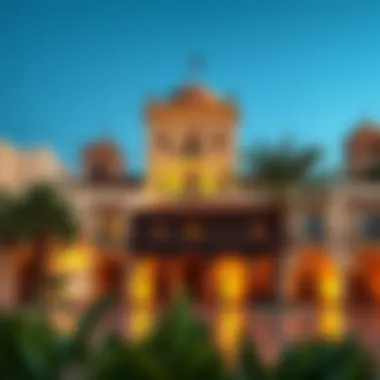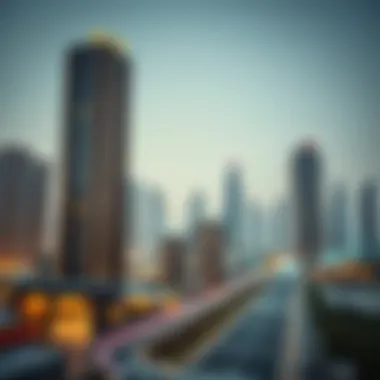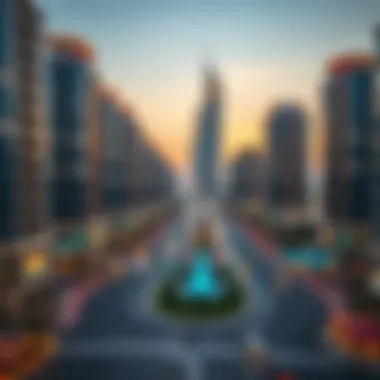Baraka Development: Insights into Dubai's Real Estate Growth


Intro
Dubai's real estate market is a melting pot of cultures, ambitions, and architectural marvels. In recent years, the term Baraka Development has surfaced as a defining concept in understanding how the city has burgeoned into a global property hotspot. This piece navigates the intricate web of cultural, economic, and architectural influences that shape property development within this vibrant milieu.
For potential investors, seasoned brokers, and curious tenants alike, grasping the essence of Baraka Development unlocks a deeper understanding of what makes Dubai's property market tick. It’s not just about concrete structures or shiny facades; it’s about creating spaces that resonate with a sense of community and belonging, bolstered by economic viability and cultural heritage.
As we delve into the heart of Baraka Development, you’ll discover insights that marry local tradition with modern aspirations, and how these elements coalesce to foster an ecosystem ripe for growth. Stay tuned as we peel back the layers, revealing how past practices inform present trends and what the future might hold for Dubai's expansive real estate landscape.
Understanding Baraka Development
Understanding Baraka Development is paramount in comprehending the broader real estate landscape in Dubai. The term 'Baraka' resonates with deep cultural and historical significances that directly influence property development approaches within the emirate. As Dubai continues its rapid expansion, gleaning insights into Baraka enables investors, buyers, brokers, and developers to navigate potential pitfalls and seize opportunities.
One significant aspect is its cultural underpinnings. Baraka signifies blessings and prosperity, embedding itself in the societal context where development occurs. Recognizing this connection can shape marketing strategies and build communal trust, ultimately leading to successful projects that resonate with potential buyers. Also, drawing from the concept that growth is not purely economic; it encompasses communal, environmental, and aesthetic dimensions makes the development of real estate more holistic.
Moreover, comprehending Baraka Paves the way for sustainable practices. This focus aligns well with global sustainability goals, particularly in urban developments. In an era of environmental consciousness, stakeholders who appreciate these dimensions are likely to be better positioned in the market.
Additionally, Baraka Development can also inform architectural choices, ensuring that the built environment harmonizes with both history and modern aspirations. In a vibrant market like Dubai, fostering this blend of tradition and innovation can lead to iconic projects that stand the test of time.
Defining Baraka in Real Estate
Defining Baraka in real estate transcends mere terminology; it is about understanding how it encapsulates the essence of development. Baraka serves as a principle guiding real estate developers toward integrating cultural values and sustainable practices in their projects. Developers who absorb the philosophy behind Baraka tend to focus on creating spaces that provide more than shelter; they foster communities. These communities are designed to be vibrant, accessible, and aligned with the residents’flavor.
One might think of Baraka as a yardstick measuring the impact of property development on the overall community and environment. A project steeped in Baraka isn't just a financial investment; it’s also a commitment to contributing positively to societal dynamics. This combined view positions Baraka as a unique indicator of success in real estate.
Cultural Relevance of Baraka
The cultural relevance of Baraka cannot be overstated. In Dubai, where East meets West, the fusion of various cultures creates a fertile ground for innovative real estate solutions. Baraka embodies this intersection by reflecting local traditions alongside contemporary aspirations. The architectural manifestations of Baraka often draw inspiration from historical designs, allowing for a richer narrative within the urban fabric.
By embracing Baraka, developers can create spaces that speak to the heritage of the region. This embrace of culture often leads to projects that attract not just local residents but also international buyers interested in the unique Dubai experience. Spaces infused with Baraka often become cultural hubs, enhancing the overall appeal of neighborhoods and communities.
Ensuring that developments echo the local culture fosters a sense of belonging and enhances community ties. From markets to communal areas laced with tradition, the importance of Baraka in real estate is synonymous with building spaces that nurture a sense of identity.
Historical Context of Property Development
To fully appreciate Baraka development, it is vital to contextualize the historical backdrop of property development in Dubai. The rapid urbanization of Dubai, especially from the late 20th century onwards, showcases how traditional values can exist alongside modern needs. Initially, property development in the region was characterized by simplistic designs and utilitarian structures to support the population's basic needs.
However, the dawn of the 21st century brought about a paradigm shift. The introduction of luxury and high-end developments shifted the focus toward extravagant designs and lifestyles, often detaching the developments from their cultural roots. Against this backdrop, Baraka emerges as a breathing force inspiring many to rethink project designs—pushing for a blend that resonates with both history and contemporary living.
The historical lens provides critical insight into how developers can learn and adapt from past successes and failures. For instance, projects that disregarded local sentiments often faced backlash, proving that Baraka is not just a guiding principle but a necessity for property success.
The Role of Baraka in Urban Planning
Baraka, a term that encapsulates a sense of blessing or positive energy, plays a pivotal role in shaping urban planning within Dubai’s landscape. The integration of Baraka in development strategies can elevate not just the aesthetic allure of structures, but also enhance overall community interactions. This section delves into the multifaceted aspects of Baraka in urban planning by shedding light on its influence in creating spaces that resonate with both tradition and modernity.
Integrating Tradition and Modernity
When it comes to integrating tradition and modernity in urban development, Baraka Development serves as a bridge between diverse cultural narratives. In a city like Dubai, where skyscrapers like the Burj Khalifa stand tall alongside historic districts like Al Fahidi, the juxtaposition is both intriguing and complex.


Adopting an approach that respects historical context while embracing cutting-edge architectural innovations is key. For instance, the use of traditional motifs in contemporary building designs not only honors the past but also meets the demands of modern living. Developers might find it beneficial to collaborate with local artisans to incorporate traditional crafts into new structures, thus enriching the city’s cultural fabric while addressing modern needs. This synergy can cultivate a unique identity for a neighborhood, attracting tourists and residents alike.
Sustainability Considerations
Sustainability is no longer just a trend; it’s a necessity, especially in rapidly growing urban areas like Dubai. Implementing Baraka principles in urban planning can lead to sustainable development that harmonizes with the environment.
- Utilization of Eco-Friendly Materials: Developers are encouraged to source materials that are not only sustainable but also culturally significant, thus creating a dual impact.
- Green Infrastructure: Integrating parks and green roofs into urban spaces not only contributes to biodiversity but also provides residents with much-needed recreational areas. It’s about creating a balance between the built environment and natural habitats.
- Water Conservation Techniques: Given Dubai’s arid climate, innovative water management systems are paramount. Collecting rainwater, recycling wastewater, and using drought-resistant landscaping are practices that embody Baraka’s respect for the natural resources.
These sustainability efforts not only support the environment but also enhance the quality of life for future generations, reinforcing the very essence of Baraka.
The Influence of Community Engagement
Community engagement is an often-overlooked element in urban planning. However, incorporating Baraka into this aspect can greatly influence the success of development projects. When communities feel involved and valued, it fosters a sense of ownership and pride.
- Participatory Design Workshops: Engaging locals in the design process of new developments can elicit valuable insights that developers might not consider otherwise. This approach could result in spaces that better reflect community needs.
- Feedback Mechanisms: Establishing channels for ongoing dialogue allows residents to express their concerns and celebrate successes in real-time, aiding continuous improvement.
- Cultural Events and Initiatives: Hosting events that highlight local traditions can create opportunities for residents to connect and learn from one another, enriching the community’s social fabric.
In a nutshell, the role of Baraka in urban planning transcends mere aesthetics; it infuses vitality, enhances sustainability, and galvanizes community involvement in the ever-evolving landscape of Dubai. By adhering to these principles, stakeholders can not only maximize their investments but also contribute to the creation of a vibrant urban environment that respects both its past and future.
Baraka Development in Practice
The concept of Baraka Development holds significant weight in the realm of real estate within Dubai. This approach imbues development projects with not only a financial motive but also a deep cultural resonance. As the bustling city continuously evolves, the integration of Baraka in practice becomes vital. This section will explore tangible examples, highlight key lessons from past endeavors, and address the various challenges encountered during implementation, providing a well-rounded perspective on Baraka’s role in shaping the future of the city’s architectural landscape.
Case Studies of Successful Projects
Throughout Dubai, various projects stand as beacons of Baraka Development. One notable example is the Dubai Creek Tower. Designed to be taller than the Burj Khalifa, it encapsulates the blend of modern architecture with cultural significance. The planning process involved not just engineers and architects but a host of cultural advisors to ensure the design truly reflects the heritage of the Emirate. Community spaces are interwoven within the commercial aspects of the tower, providing a microcosm of life that resonates with the local populace.
Another illustrative case can be found in the Bluewaters Island Project. This development combines luxury living with accessible recreation areas, aiming to foster community interaction. By prioritizing open spaces and facilities for people, it stands apart as a prime example where Baraka principles have informed the design, creating a vibrant hub that draws both residents and tourists alike.
Lessons Learned from Previous Developments
The intricacies of Baraka Development in practice provide invaluable insights for future projects. One crucial takeaway is the importance of engaging local communities early on. Projects that have succeeded in integrating Baraka have consistently involved stakeholder feedback. For instance, in the Aljada development, planners held community workshops to gather input, leading to designs that better meet the needs and desires of residents.
Additionally, flexibility in design is key. The Hawthorn Residences project faced obstacles due to rigid planning frameworks. A recalibration of priorities, focusing more on sustainability and cultural alignment rather than solely profit, turned it around. This demonstrates that adherence to Baraka can not only navigate challenges but can also enhance long-term viability and success of developments.
Challenges Faced in Implementation
Implementing Baraka Development isn’t all sunshine and rainbows. Several challenges can emerge during the process, starting from financial constraints to regulatory hurdles. For instance, in the case of the Waterfront City project, initial phases suffered from funding shortages, which delayed its progress significantly. Balancing profit margins while adhering to Baraka principles often creates tension amongst stakeholders.
Moreover, as urban density increases, maintaining the delicate balance between tradition and modernity becomes increasingly difficult. The Royal Atlantis Resort faced scrutiny for straying too far from local architectural styles in its design, prompting pushback from cultural purists. Hence, developers must navigate the often turbulent waters of regulation, community expectation, and commercial viability. It’s a tightrope walk that requires astute decision-making and a genuine commitment to the Baraka philosophy.
As we walk through the landscape of Baraka Development in Dubai, we gain a clearer understanding of its practical implications. The synergy between successful project examples, the lessons learned from prior experiences, and the challenges faced provide a comprehensive view that is essential for all stakeholders to consider. With this knowledge, investors, developers, and community members alike can better contribute to a flourishing real estate market that embodies the essence of Baraka.
Market Trends Influencing Baraka Development
The real estate landscape in Dubai is a dynamic tapestry woven from various threads of economic, technological, and social fabric. Understanding market trends in Baraka Development is not merely academic; it is essential for anyone invested in the Dubai property market, be they investors, buyers, or real estate professionals. These trends reflect the underlying currents reshaping the market and influence decision-making strategically. The relevancy of this topic lies in identifying critical drivers that can enhance investment viability and demonstrate the adaptability required to thrive in a constantly evolving environment.
Economic Indicators


Economic indicators serve as the backbone of any robust analysis relating to real estate. In Dubai, these indicators often include GDP growth, employment rates, and inflation, amongst others. For instance, a sustained increase in foreign direct investment (FDI) is typically a positive signal. It suggests that Dubai continues to be seen as a viable destination for international business and living.
Nevertheless, one cannot ignore the influence of tourism on property development. The Dubai Expo 2020 showcased the emirate's appeal and generated significant momentum for the construction and property sectors. This momentum often leads to short-term spikes in demand resulting in property value appreciation.
"The connection between economic growth and demand for real estate in Dubai cannot be overstated."
Moreover, sector-specific economic trends, such as the growth in technology and finance industries, play a role in increasing housing demand tailored to the needs of professionals in these sectors. As industries become more diverse, the necessity to adapt existing properties or develop new ones aligned with these trends becomes clear.
Technological Innovation in Real Estate
The real estate arena is seeing a revolutionary shift through technological integration. Innovations such as smart home technology, virtual reality viewings, and blockchain for transparent property transactions are gaining traction in Dubai. These advancements help streamline processes, enhance user experiences, and cater to tech-savvy consumers.
For example, virtual reality allows prospective buyers or tenants to tour properties from the comfort of their current location. This experience can save time and resources, making it easier for buyers to make informed decisions. Additionally, blockchain technology is carving its niche in ensuring trust in transactions, significantly reducing fraud.
This technological evolution is essential in attracting a modern buyer who values customization and efficiency. Developers that embrace these innovations often find themselves with a competitive edge and higher demand for their offerings.
Shifts in Consumer Preferences
Consumer preferences in Dubai’s housing market are continually evolving. A few key shifts have emerged among buyers and tenants. There is a noticeable trend toward sustainability and eco-friendly developments. Modern consumers are showing a heightened awareness of environmental issues, prompting developers to incorporate green building standards into their projects. This marks a decisive turn in the market.
Furthermore, there is a growing preference for mixed-use developments. Consumers increasingly desire communities that offer live-work-play opportunities in close proximity rather than standard residential-only environments. This inclination significantly affects how properties are developed, as community-oriented growth allows for better quality of life while also driving up property values.
In addition to this, affordability continues to be a crucial factor. Despite the glittering skyline, many are seeking value-driven options that still provide access to the vibrant lifestyle Dubai offers.
Understanding these shifts provides valuable insight into the future of Baraka Development. By aligning project designs with consumer expectations, stakeholders can maximize both investment returns and tenant satisfaction. Each of these trends offers a foundation for evaluating opportunities in the Dubai property market, making it all the more vital to stay informed.
Baraka Development and Investment Opportunities
Baraka Development serves as a cornerstone in the vibrant real estate landscape of Dubai. This concept not only encompasses physical properties but also touches deeply on cultural, social, and economic elements. Understanding the potential investment opportunities related to Baraka Development is crucial for various stakeholders: investors, buyers, brokers, developers, and tenants. Investing in this area presents a unique blend of rewards, risks, and considerations that are intrinsically tied to the ever-evolving nature of Dubai’s property market.
Identifying High-Potential Areas
Investment starts with the right location. In Dubai, specific neighborhoods have emerged as high-potential areas due to various factors. For instance:
- Downtown Dubai: This area remains highly sought after, primarily due to its iconic attractions like Burj Khalifa, which offers both residential and commercial opportunities.
- Dubai Marina: Known for its stunning waterfront views, this locality is gaining traction due to its lifestyle offerings and proximity to crucial amenities.
- Jumeirah Village Circle (JVC): This district is gradually drawing attention from families looking for a blend of affordability and accessibility to schools and parks.
Analyzing infrastructure development, accessibility, and upcoming projects is essential to identify areas poised for growth. Investors should keep a close eye on governmental initiatives aimed at enhancing transport links or public facilities which could drive up property values in certain locales.
Strategies for Investors
Navigating the investment landscape in Baraka Development requires a keen strategy. Here are some approaches that can optimize investment outcomes:
- Market Research: Stay informed about market trends and consumer preferences. Understanding when to buy and sell can significantly impact returns.
- Networking: Building strong relationships with local brokers, developers, and even residents can offer insights not available in reports. A friendly conversation might reveal a neighbor looking to sell or an upcoming lease opportunity.
- Diversification: Investing in various types of properties (residential, commercial, or mixed-use) can reduce risk. Combining high-value properties with those that mitigate expenses may ensure steady revenue streams.
- Long-Term Perspective: While immediate gains are tempting, a long-term investment strategy often leads to better rewards, particularly in a market characterized by fluctuations.
Navigating Regulatory Frameworks
Investors face a maze of regulations in Dubai. Understanding and navigating these frameworks becomes imperative for success. Key considerations include:


- Ownership Laws: Familiarization with freehold versus leasehold properties ensures that investors grasp their rights and obligations.
- Licensing Requirements: Different types of investment (e.g., short-term rentals) may have distinct licensing needs. Failing to comply can lead to costly penalties.
- Tax Implications: While Dubai boasts no property tax, understanding local levies or fees is vital. Moreover, potential investors should explore the impact of VAT on their transactions.
As legal landscapes can shift, consulting with legal experts can save a lot of headaches. Being proactive in clarifying such details leads to a smoother transaction process, allowing investors to focus on the growth potential of Baraka Development.
"A well-informed investor is often a successful investor. Understanding the regulations helps mitigate risks in Dubai's dynamic market."
In summary, the opportunities that lie within Baraka Development are numerous but require careful consideration and informed decision-making. The thoughtful alignment of strategies, coupled with a grasp of the regulations, can unlock significant potential in Dubai’s real estate market.
Future of Baraka Development in Dubai
The future of Baraka Development in Dubai represents not just a pathway to economic growth but also a canvas of opportunity for cultural expression and community building. As Dubai continues to evolve, so do the paradigms of real estate development. This section unpacks the significance of Baraka in shaping the urban sprawl of this city, bridging the gap between past heritages and future aspirations.
Predictions for Market Growth
Mindfully forecasting the real estate market, specifically within the realm of Baraka Development, unveils a series of insightful predictions. Data shows that property values are likely to experience an upward trajectory, especially in areas where sustainability and community needs align seamlessly. A few indicators to ponder include:
- Increased Demand for Mixed-Use Developments: Consumers are gravitating toward properties that offer a blend of residential, commercial, and recreational spaces, ideally situated within a walkable environment.
- Investment in Eco-Friendly Initiatives: Investors are increasingly favoring developments that integrate green spaces and utilize sustainable building practices, promising better long-term returns.
- Strong Demographic Trends: As Dubai's populace grows, fueled by expatriates and investors from diverse backgrounds, the demand for real estate is set to skyrocket.
“Understanding the market trends today is key to predicting tomorrow’s successes. Investors must adapt to shifting dynamics.”
Emerging Trends to Watch
Keeping an eye on the emerging trends linked to Baraka Development is prudent for anyone interested in Dubai's real estate sector. Some noteworthy movements to consider include:
- Cultural Integration in Projects: Developers are increasingly embedding local culture in their architectural designs. This helps resonate with both residents and tourists alike.
- Technological Integration: The rise of smart homes and automated systems is transforming how properties are perceived and operated.
- Focus on Community Spaces: There is a noticeable shift towards creating shared spaces that promote interaction among residents, breaking conventional ideas of residential living.
The Role of Innovation and Technology
The acceleration of technological advancements will undoubtedly influence Baraka Development's framework in Dubai. Here are some significant aspects to consider:
- Smart Building Technologies: Utilizing IoT devices to enhance efficiency in energy usage could be a game-changer for developers.
- Virtual Reality and Augmented Reality: These tools are redefining property tours and planning processes, making it easier for buyers to visualize their future homes before construction is completed.
- Data-Driven Decision Making: With advanced analytics, real estate developers can tailor projects based on market demands and consumer behavior more effectively than ever.
As we look to the horizon of Baraka Development, it’s clear that innovation and cultural relevance will be pivotal in navigating the future real estate landscape of Dubai. Investors, brokers, and developers must keep their fingers on the pulse of these developments if they wish to capitalize on the opportunities that lie ahead.
Epilogues about Baraka Development
The significance of Baraka Development in the realm of Dubai's real estate cannot be overstated. It encapsulates a broader understanding of how cultural principles intermingle with economic ventures, ultimately shaping the skyline of this vibrant city. In this section, we will distill the insights garnered throughout the article, focusing on the essential aspects of Baraka that resonate with the investors, buyers, brokers, developers, and tenants.
"Understanding Baraka is not just about properties; it is about the spirit that drives sustainable growth beyond mere transactions."
Summarizing Key Insights
To effectively frame our understanding of Baraka Development, it is pertinent to recall some fundamental insights:
- Cultural Significance: Baraka extends beyond financial transactions; it embodies the integration of community values within property development, fostering a sense of belonging and long-term engagement among residents.
- Historical Context: The evolution of property development in Dubai reveals how Baraka has influenced urban growth, evolving from traditional practices to modern developments without losing sight of its roots.
- Urban Planning: The principles of Baraka guide urban planners in striking a balance between maintaining cultural identity and introducing modern infrastructures, thereby creating spaces that reflect both heritage and progress.
- Economic Viability: Developing real estate that adheres to the tenets of Baraka enhances market resilience, attracting investors through stability and aligning with shifting consumer expectations for sustainable living.
By weaving these insights, it becomes clear that Baraka serves as both a guiding philosophy and a practical framework that underpins real estate growth in Dubai.
Final Thoughts on Real Estate Growth
In closing, it is evident that the future of Dubai's real estate landscape hinges on the principles embodied by Baraka Development. As various sectors evolve, the interplay between tradition and innovation will increasingly direct development strategies.
Investors must remain vigilant to the nuances of Baraka, understanding that aligning their goals with these cultural contexts can usher in methods that are not only profitable but also responsible. The lessons learned from past developments underscore the importance of community engagement and sustainability, which are pivotal for fostering long-term growth and stability.
In a rapidly changing market, the knowledge gained from Baraka development will undoubtedly guide stakeholders toward making informed and impactful decisions. As we look ahead, it is crucial to adopt a perspective that respects historical contexts, embraces modernity, and prioritizes the well-being of communities that the developers aim to serve.







